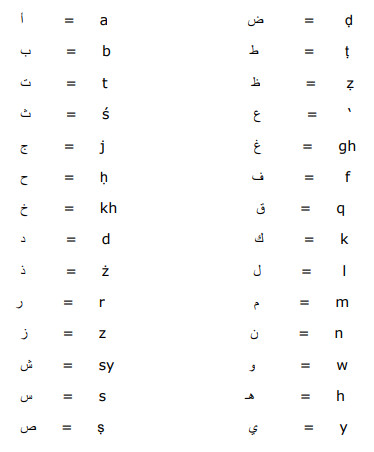Author Guidelines
Articles submitted for publication must conform to the following guidelines:
- General guidelines:
- Articles should discuss the themes of Al-Qur'an and Hadits; Islamic Communication, Broadcasting, and Journalism; Da'wah; Development of Islamic society; Islamic Education; and Islamic Thought
- Articles are basically written in Indonesian, but this journal prefer articles written either in English or Arabic;
- Articles must be typed in one-half spaced on A4-paper size;
- Articles‘ length is about 6,000-7,000 words or 20-25 pages;
- Abstract of 150-300 words should accompany every submission;
- The submission should include full name(s) of the author(s), along with his/her/their institution and complete address;
- Arabic words should be transliterated according to the style of this journal; ∙ Intending authors should adopt the style used in this journal, Chicago Styles.
- A reference list of all material mentioned in the article, including books, book chapters, journal articles, court decisions, and laws, should be provided at the end of the article; ∙ All submissions should be in OpenOffice, Microsoft Word, rtf, or WordPerfect document file
- Writing Style
- Title of articles should be specific and efficient (the maximum length of a title is 14 words) ∙ Two types of abstract, one in Arabic and the other in English, are typed in one space if the article is written in Arabic.
- Keywords should include 5 (five) terms that reflect the basic concept contained by the
- The articles should be typed with a 12-point Times New Roman font, except for Arabic texts should use 14-point Traditional Arabic.
- When a source is cited for the first time, full information is provided: full name(s) of author(s), title of the source in italic, place of publication, publishing company, date of publication, and the precise page that is cited.
- Use Mendeley or Zotero to create footnotes and bibliography.
Examples of Footnote Chicago style
Book:
Uyuni, Badrah. 2023. Media Dakwah Era Digital. Google Books. Penerbit Assofa.
Uyuni, Badrah. 2023. Media Dakwah Era Digital. Google Books. Penerbit Assofa. https://books.google.co.id/books?hl=id&lr=&id=tB3lEAAAQBAJ&oi=fnd&pg=PA13&ots=9Ruf2scgl-&sig=QeparS7TmVuA0V9QwFhnbkrdy28&redir_esc=y#v=onepage&q&f=false.
Uyuni, Badrah. 2023. Media Dakwah Era Digital. Google Books. Penerbit Assofa. https://books.google.co.id/books?hl=id&lr=&id=tB3lEAAAQBAJ&oi=fnd&pg=PA13&ots=9Ruf2scgl-&sig=QeparS7TmVuA0V9QwFhnbkrdy28&redir_esc=y#v=onepage&q&f=false.
Journal:
Badrah Uyuni, Khairan Muhammad Arief, & Adnan, M. (2023). Contribution of Woman Ulama in The Digital Era. International Journal of Emerging Issues in Islamic Studies, 3(1), 1–11. https://doi.org/10.31098/ijeiis.v3i1.1239
Hamid, Abdul, Muhammad Utsman Shalih, and Badrah Uyuni. 2023. “Christianization as a Challenge for Islamic Daʿwah in Indonesia.” Millah : Jurnal Studi Agama, February, 19–60. https://doi.org/10.20885/millah.vol22.iss1.art2.
Conference/PROSIDING:
Clancey, W.J. (1983). Communication, Simulation, and In-telligent Agents: Implications of Personal Intelligent Machines for Medical Education. In Proceedings of the Eighth International Joint Conference on Artificial Intelligence, 556-560. Menlo Park, Calif.: International Joint Conferences on Artificial Intelligence. Inc.
REPORT:
Rice, J. (1986). Poligon: A System for Parallel Problem Solving, Technical Report, KSL-86-19, Dept. of Computer Science, Stanford Univ.
TESIS:
Clancey, W.J. (1979). Transfer of Rule-Based Expertise through a Tutorial Dialogue. PhD Dissertation, Department of Computer Science, Stanford University.
WEBSITE:
Ivey, K.C. (2 September 1996). Citing Internet sources URL http://www.eei- alex.com/eye/utw/96aug.html.
The paper will be reviewed and edited without changing any substantial contentsThe rejected paper will be notified to the author via email.
Bibliographical reference must be noted in footnote and bibliography according to Al-Risalah : Jurnal Studi Agama dan Pemikiran Islam Journal style
Transliteration Guidelines
- If an Indonesian term exists for a word, use it.
- All technical terms from languages written in other than Indonesian language or in non-Latin
- alphabets must be italicized and fully transliterated with diacritical marks (macrons and dots),
- g., ʿasyāʾ.
- Diacritics should not be added to personal names, place names, names of political parties and
- organizations, e.g., Jamal ʿAbd al-Nasir.
- Inseparable prepositions, conjunctions, and other prefixes are connected with what follows by a
- hyphen: bi-, wa-, li-, la-. Example: fī al-ʿirāq wa-miṣr. (Note: the preposition fī is not an
- inseparable prefix in the Arabic script and thus is not treated as one by IJMES.)
- When one of the above prepositions or conjunctions is followed by al, the a will elide,
- forming a contraction rendered as wa-l-, bi-l-, li-l-, and la-l-. Example: fī miṣr wa-l-ʿirāq.
- The definite article (e.g., the Arabic al-) is lowercase everywhere, except when the first word of
- a sentence or an endnote.
- The Arabic tāʾ marbūṭa is rendered ah not at, except in iḍāfah constructions.
- When an Arabic name is shortened to just the surname, the al- is retained. For example, Hasan
- al-Banna becomes al-Banna. Connectors in names—such as bin, abu, etc.—are lowercase only
- when preceded by a name, e.g., Usama bin Ladin, but Bin Ladin, Ibn Khaldun, etc.
- Long vowel should use diacritic mark '-' (dash) above the vowel letters: ā, ī, ū. For
- examples: al-masājid li al-ṣāliḥīn, al-jāmi’ah al-ḥukūmiyyah, żālika al-kitāb lā raiba fīh.
- See below for a character-by-character map of our transliteration system:

Please download document for Author Guidelines














